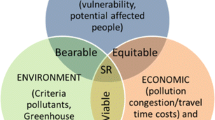Abstract
As the material basis for vehicular network, road infrastructure network plays an important role in transportation. Reasonable road network density and traffic demand work as a good foundation for easing the traffic pressure. Based on the defined road grid cell in a grid network, this paper proposes a model to estimate the floor area ratio upper limit from the perspective of traffic demand-supply equilibrium. Based on a typical scenario, an automatic tool was designed, and some parameters were set up to do numerical simulation. The simulation results indicate that the floor area ratio upper limit and the road grid cell area followed the power-law distribution, and the approximate power exponent was −0.866. When the private car percent transferred to 1% of the public transport, the floor area ratio upper limit increased by 2.8%. In the meanwhile, the economic benefits increased by RMB 44.8 million at a road grid cell of 40,000 m2 with the floor area ratio of 2. Finally, it is found that a simple floor area ratio value is deficient in comparison with the current floor area ratio regulations of Jinan. And the corresponding road grid cell area can’t be neglected and should be comprehensively considered.






Similar content being viewed by others
References
Meng Y, Zhang FR, An PL, Dong ML, Wang ZY, Zhao TT (2008) Industrial land-use efficiency and planning in Shunyi, Beijing. Landscape Urban Plan 85:40–48
Brueckner JK, Sridhar KS (2012a) Measuring welfare gains from relaxation of land-use restrictions: the case of India’s building-height limits. Reg Sci Urban Econ 42:1061–1067
Gong J, Chen W, Liu Y, Wang J (2014) The intensity change of urban development land: implications for the city master plan of Guangzhou, China. Land Use Policy 40(2014):91–100
Wang Y (2011) Study on the intensive use of urban land—a case study of hill area in the middle of Sichuan Province. Energy Procedia 5(2011):85–89
Guang-zhong CAO, Xiao BAI (2010) On the location difference and influencing factors of the economic density of urban construction land in China: evidence from 273 Prefecture-level cities China population, resources and environment 20(2)
Cai H, Wang Z, Zhang Q (2017) To build above the limit? Implementation of land use regulations in urban China. J Urban Econ 98:223–233
Akinori M, Hirotaka K, Katsunori S, Tatsuya S (2000) Transportation impact assessment on urban development using NETSIM[J]. Comput Civil Build Eng 2000:1519–1526
Litman T (2016), Land use impacts on transport how land use factors affect travel behavior, Victoria transport policy institute
Bertaud A, Brueckner JK (2005) Analyzing building-height restriction: predicted impacts and welfare costs. Reg Sci Urban Econ 35:109–125
Bertaud A (2011) Mumbai FAR/FSI conundrum. The perfect storm: the four factors restricting the construction of new floor space in Mumbai Available at: http:// alain-bertaud.com
Brueckner JK, Fu S, Gu Y, Zhang J (2015) Measuring the stringency of land-use regulation and its determinants: the case of China’s building-height limits. Working Paper
Gao X, Asami Y, Katsumata W (2006) Evaluating land-use restrictions concerning the floor area ratio of lots. Environ Plan C: Govern Policy 24:515–532
KusumJoshi K (2009) TatsuhitoKono,Optimization of floor area ratio regulation in a growing city. Reg Sci Urban Econ 39(4):502–511
Hsieh S, Schülerc N, Shi Z, Fonseca JA, Maréchal F, Schlueter A (2017) Defining density and land uses under energy performance targets at the early stage of urban planning processes. CISBAT International Conference – Future Buildings & Districts – Urban Form, Energy and Technology, Lausanne, Switzerland
Tsai Y-H (2014) Location-demand-based residential floor area ratio distribution method. Urban Stud 51(12):2685–2702
Iravani H, Mirhoseini A, Rasoolzadeh M (2011) Defining land use intensity based on roadway level-of-service targets[J]. J Transport Land Use 4(1):59–69. https://doi.org/10.5198/jtlu.v4i1.168
Acknowledgements
The paper was written when the first author visited NDSU as a visiting scholar supported by China Scholarship Council. The data collection and calculation was assisted by Zhang Hong, an undergraduate student.
Funding
Funded by Shandong Province Higher Educational Science and Technology Program (J17KA208).
Author information
Authors and Affiliations
Corresponding author
Additional information
Publisher’s Note
Springer Nature remains neutral with regard to jurisdictional claims in published maps and institutional affiliations.
Rights and permissions
About this article
Cite this article
Li, M., Ran, J., Niu, X. et al. Estimating the Floor Area Ratio of the Vehicular Infrastructure Network Based on Road Grid Cell. Mobile Netw Appl 25, 650–659 (2020). https://doi.org/10.1007/s11036-019-01226-6
Published:
Issue Date:
DOI: https://doi.org/10.1007/s11036-019-01226-6




